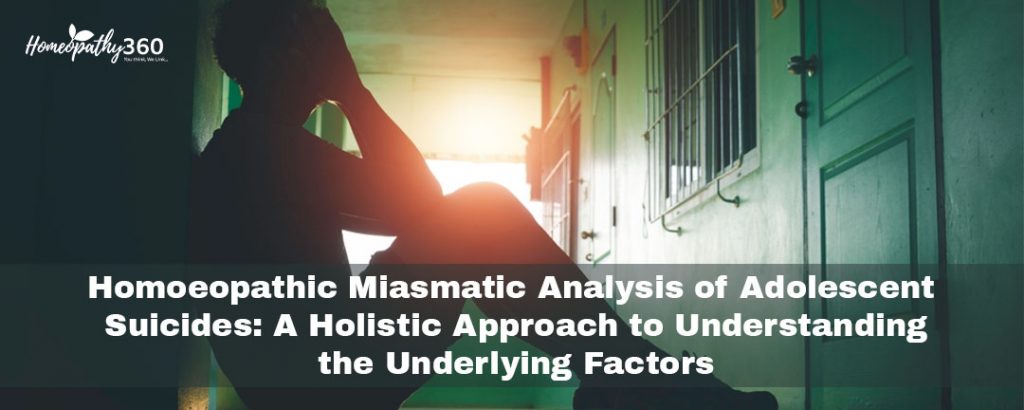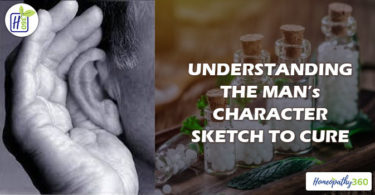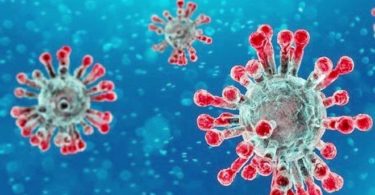
Abstract:
Adolescent suicides, a global tragedy, require a comprehensive approach to comprehend their complex contributing factors. This article introduces homoeopathic miasmatic analysis as a holistic method for understanding the psychological, emotional, and social aspects surrounding adolescent suicides. Homoeopathy, emphasizing holistic patient care by identifying root causes, is discussed within this context. Miasmatic analysis explores an individual’s miasmatic constitution, impacting physical, mental, and emotional health.
Adolescence, marked by physical and emotional changes, academic pressures, peer relationships, and identity formation, becomes even more challenging when combined with potential underlying miasmatic predispositions. This article briefly examines specific miasmatic dispositions:
Psoric Miasm: Adolescents with a psoric disposition may struggle with self-esteem, potentially leading to isolation and depression.
SycoticMiasm: Those with a sycotic disposition may experience excessive academic or social pressure, resulting in feelings of worthlessness.
Syphilitic Miasm: The syphilitic disposition may lead to self-destructive tendencies and emotional turmoil.
Tubercular Miasm: Adolescents with a tubercular disposition may engage in high-risk behaviours.
Homoeopathic miasmatic analysis allows for personalized treatment plans addressing root causes, integrating homoeopathy with traditional counselling, family support, and mental health education for comprehensive adolescent suicide prevention. Early intervention, open communication, and creating safe spaces for emotional expression are essential components of this holistic approach.
Introduction
Adolescent suicides represent a tragic and intricate challenge that continues to plague societies worldwide. Gaining insight into the multifaceted factors that contribute to these heart-wrenching occurrences is paramount for the development of effective prevention and support strategies. In this article, we delve into the concept of homoeopathic miasmatic analysis as a holistic approach to comprehending the psychological, emotional, and social dimensions that surround adolescent suicides.
Homoeopathy and Its Miasmatic Analysis
Homoeopathy stands as a system of alternative medicine renowned for its emphasis on treating patients with highly diluted substances to stimulate the body’s innate healing mechanisms. This approach sets out to understand the individual as a whole, seeking to identify the root cause of an ailment rather than merely addressing its surface symptoms.
Miasmatic analysis, within the realm of homoeopathy, refers to the evaluation of an individual’s miasmatic constitution. Miasms can be described as deep-seated energetic imprints or inherited predispositions that have the potential to significantly influence a person’s physical, mental, and emotional health.
Understanding Adolescent Suicides
Adolescence represents a vulnerable phase in life, marked by a multitude of physical and emotional changes. The pressures stemming from academic performance, peer relationships, social media, family dynamics, and identity formation can all contribute to stress and emotional turmoil. When these factors intersect with a potential underlying miasmatic disposition, they create a complex web of emotions that some adolescents struggle to cope with, ultimately resulting in suicidal thoughts.
Homoeopathic Miasmatic Analysis of Adolescent Suicides
Psoric Miasm: Adolescents with a psoricmiasmatic background may grapple with self-esteem issues and a pervasive sense of inadequacy. These feelings can become exacerbated during adolescence when peer comparisons and societal expectations intensify emotional challenges, possibly leading to isolation and depression.
Sycotic Miasm: Individuals with a sycoticmiasmatic disposition may display tendencies toward perfectionism, competitiveness, and an overwhelming fear of failure. In the context of adolescence, this could translate into an overwhelming pressure to excel academically or socially, contributing to feelings of worthlessness and hopelessness when they fall short of high expectations.
Syphilitic Miasm: The syphilitic miasmatic disposition may manifest as destructiveness, self-destructive tendencies, and an overpowering sense of doom. Adolescents with this disposition may be more prone to extreme emotional turmoil and a heightened risk of self-harm or suicidal thoughts.
Tubercular Miasm: Adolescents with a tubercular miasmatic predisposition may exhibit restlessness, impulsiveness, and an insatiable desire for excitement. Such traits could drive them towards engaging in high-risk behavior, substance abuse, or reckless actions, thereby increasing their vulnerability to suicidal tendencies.
Holistic Intervention and Prevention
Homoeopathic maismatic analysis offers an alternative lens through which to view the unique psychological and emotional makeup of each adolescent. By identifying these underlying miasmatic tendencies, homoeopaths can craft treatment plans that aim to address the root causes of distress rather than merely alleviating surface-level symptoms.
Integrating homoeopathy with traditional counselling, family support, and mental health education can pave the way for a more comprehensive approach to adolescent suicide prevention. Early intervention, open communication, and the creation of a safe space for adolescents to express their emotions are vital components of this holistic strategy.
Conclusion
Adolescent suicides represent a multifaceted issue that necessitates a comprehensive understanding and proactive solutions. Homoeopathic maismatic analysis offers a complementary perspective to conventional approaches, aiding in the understanding of the emotional and psychological factors that contribute to suicidal tendencies among adolescents. By considering the miasmatic constitution and addressing the underlying causes of distress, we can create a supportive environment fostering resilience and mental well-being among our youth.
Reference: Kent, J. T. (2004). Lectures on Homoeopathic Philosophy. B. Jain Publishers.
Adolescent Suicide Trends and Challenges
Reference: Bridge, J. A., Goldstein, T. R., & Brent, D. A. (2006). Adolescent suicide and suicidal behavior. Journal of Child Psychology and Psychiatry, 47(3-4), 372-394.
Introduction to Homoeopathy
Reference: Hahnemann, S. (1996). Organon of Medicine. B. Jain Publishers.
Miasmatic Analysis in Homoeopathy
Reference: Hahnemann, S. (1994). The Chronic Diseases: Their Peculiar Nature and Their Homoeopathic Cure. B. Jain Publishers.
Psychological and Emotional Challenges in Adolescence
Reference: Arnett, J. J. (2000). Emerging adulthood: A theory of development from the late teens through the twenties. American Psychologist, 55(5), 469-480.
Miasmatic Dispositions and Their Impact
Reference: Allen, T. F. (1905). The Chronic Miasms: Psora and Pseudo-psora. B. Jain Publishers.
Integration of Homoeopathy with Counselling and Support
Reference: Bell, I. R., &Koithan, M. (2012). A model for homeopathic remedy effects: low dose nanoparticles, allostatic cross-adaptation, and time-dependent sensitization in a complex adaptive system. BMC Complementary and Alternative Medicine, 12(1), 191.





